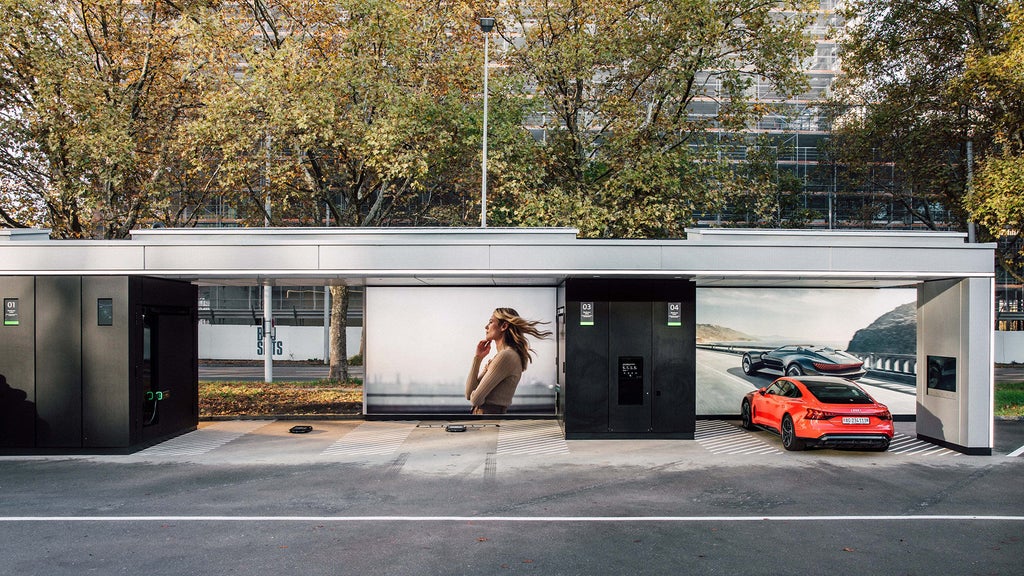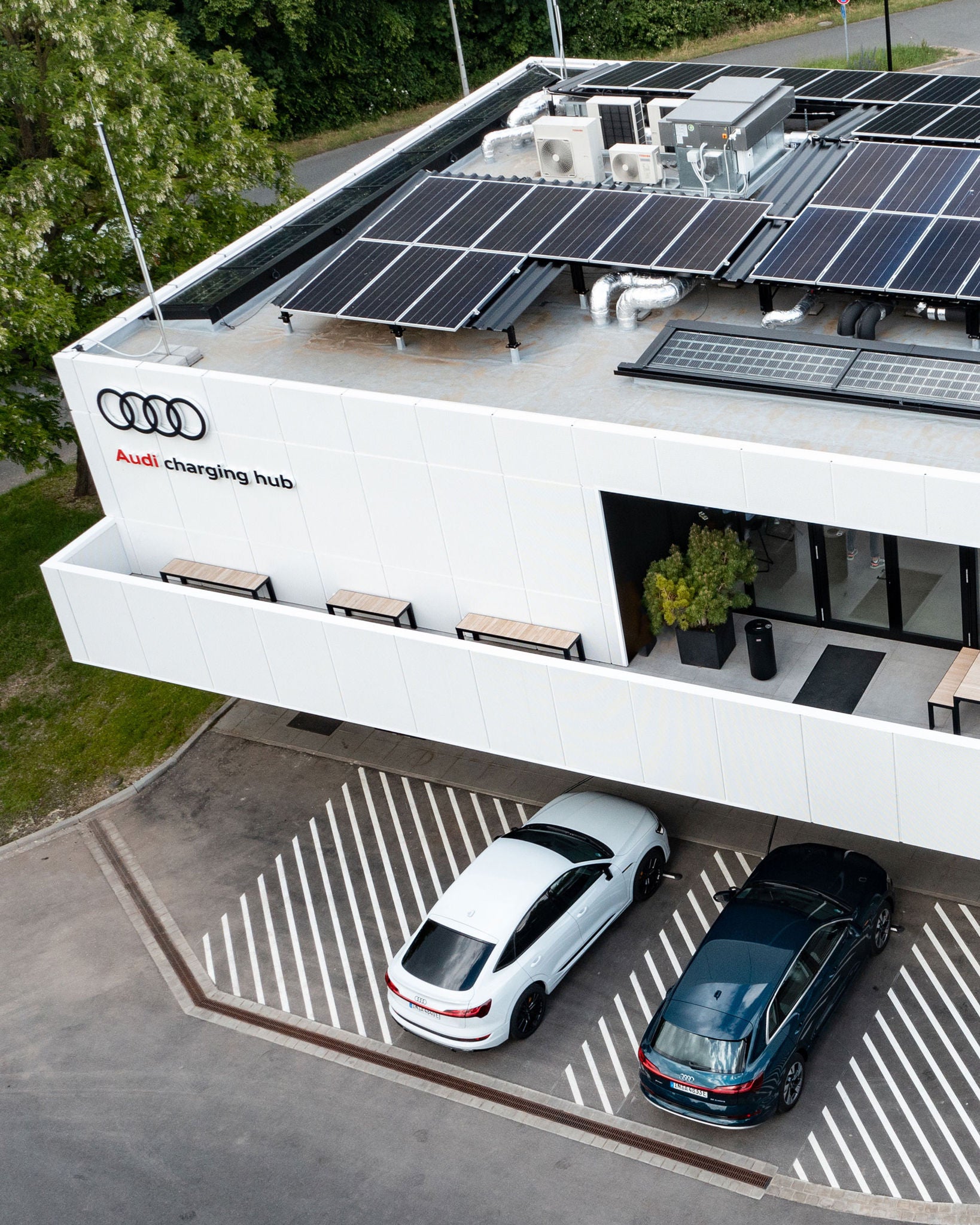Audi charging hub: flexible, sustainable, convenient
missing translation: fa.article-intro.reading-time – 06/06/2023

Zurich is the second destination worldwide to have its own Audi charging hub. At the heart of the concept are the charging cubes - modular container cubes that, in addition to a fast-charging infrastructure, also contain used, reconditioned lithium-ion batteries, also known as second-life batteries.
Audi e-tron GT quattro: Power consumption (combined) in kWh/100 km: 21.6–19.6 CO₂ emissions (combined) in g/km: 0 CO₂ emission class: A
Zurich is the second destination worldwide to have its own Audi charging hub. At the heart of the concept are the charging cubes - modular container cubes that, in addition to a fast-charging infrastructure, also contain used, reconditioned lithium-ion batteries, also known as second-life batteries.
Audi e-tron GT quattro: Power consumption (combined) in kWh/100 km: 21.6–19.6 CO₂ emissions (combined) in g/km: 0 CO₂ emission class: A
First Nuremberg now Zurich and later Salzburg, Berlin and Munich
First Nuremberg, then Zurich, then Salzburg, Berlin and Munich. The Audi charging hub’s flexible, modular charging concept is flourishing. Drivers of electric cars appreciate being close to the city and reserving spots at convenient fast-charging stations.
Loyal users: more than half return to the charging station
In Nuremberg, where the Audi charging hub has been operating since December 2021, more than half of users regularly charge their cars at the charging station. Audi registers an average of 24 charges at around 800 kWh per day in Nuremberg. On top of that, an average of 35 customers visit the approximately 200-square-meter lounge every day, which includes a 40-square-meter terrace over the charging cubes. Audi customers are increasingly using the app to reserve a charging spot for their electric car. The lounge services are frequently taken advantage of as well. Offerings like a changing station for micro-mobility batteries – for instance, for electric scooters – and a delivery service for groceries are also actively used. “The numbers and the positive customer feedback show that our concept of offering a flexible, premium fast-charging infrastructure in urban areas is panning out,” said Ralph Hollmig, the project leader for the Audi charging hub.

In Nuremberg, up to six e-cars can be charged simultaneously. A green power contract ensures that only electricity from sustainable sources is used. Photovoltaic modules on the roof provide additional green energy. Audi e-tron Sportback:Power consumption (combined) in kWh/100 km: 25.9–21.1CO₂ emissions (combined) in g/km: 0CO₂ emission class: A Audi e-tron:Power consumption (combined) in kWh/100 km: 26.1–21.7CO₂ emissions (combined) in g/km: 0CO₂ emission class: A
Fast-charging station based on a self-sufficient, sustainable charging infrastructure
Power cubes serve as energy storage in Nuremberg, as they will at all future Audi charging hub locations. These flexible container cubes can be built up and dismantled on short notice, and each unit offers two fast-charging points. Second-life batteries – that is, used lithium-ion batteries from former Audi test vehicles – serve as energy storage and provide electricity. The Nuremberg location only needs a 200-kW connection to the low-voltage grid to continually fill the storage modules thanks to its 2.45 MWh buffer storage. Audi can consequently offer sustainable fast-charging even in places where the electricity grid isn’t sufficient to operate six HPC charging points at up to 320 kW. Solar panels on the roof provide up to 30 kW of additional green energy in Nuremberg. This is enough to charge up to six electric cars simultaneously.
Compact version to open in Zurich
The compact version of the modularly designed Audi charging hub with four covered charging points at two power cubes has now been opened in Zurich's banking and insurance district in November. Thanks to its variable modular design, Audi can adapt the concept to a variety of spaces. Its low space requirements are also perfect for urban locations. “The preliminary work phases for planning and execution are accordingly short,” said the Audi project leader Hollmig.

Another plus for user-friendliness: In Zurich, cars can be loaded barrier-free across the entire width of the parking space.
Exclusive service offerings in the immediate vicinity
Audi has learned from its experiences at the pilot location when it comes to charging convenience. In Zurich, customers will be able to use a modified swivel arm to charge their cars at up to 320 kW across the entire width of the individual spaces. The operating displays at the charging points will be height-adjustable, and the areas between the cubes and vehicles will be wide enough for wheelchair users. Instead of a lounge, Audi will provide a wide-ranging service offering around the hub in Zurich. On two 55-inch screens, customers can find information about a multitude of food and fitness services, and electric bike sharing will be offered in the immediate vicinity of the fast-charging station.
After Zurich, Audi plans to open another Audi charging hub in Salzburg soon. This compact hub will also be built in the city center. Berlin and Munich will follow in 2023. One year later, Audi is planning to build eight more locations in German cities.

A more compact version of the Audi charging hub, also based on the modular principle, will be used in Zurich. This allows various sizes of charging hub to be realized with and without a lounge.
A more compact version of the Audi charging hub, also based on the modular principle, will be used in Zurich. This allows various sizes of charging hub to be realized with and without a lounge.


